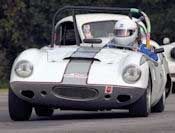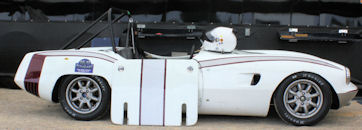Exploring the Family Tree – The Elva Courier

 Anyone interested in sports racing cars is likely to be aware of Lotus, Cooper and perhaps Lola, but may be less certain at the mention of ‘Elva.’ Club racing in the early fifties was cheap and cheerful, with many ‘specials’ constructed by innovative enthusiasts looking for maximum performance at minimum cost. One such enthusiast was Frank G. Nichols.
Anyone interested in sports racing cars is likely to be aware of Lotus, Cooper and perhaps Lola, but may be less certain at the mention of ‘Elva.’ Club racing in the early fifties was cheap and cheerful, with many ‘specials’ constructed by innovative enthusiasts looking for maximum performance at minimum cost. One such enthusiast was Frank G. Nichols.
After leaving the army he bought a small garage business at Westham in 1947 and later moved to another bigger garage in Bexhill where there was a good local following for motorsports. After gaining experience in a Lotus VI, he ordered a CSM race car, achieving some notable success, particularly at Goodwood, and attracting attention from like-minded enthusiasts. He realized that this potent little car could be further improved and marketed, and very soon he was able to produce a similar chassis. ‘Elva’ was in business!
This humble start led to Elva Engineering, with support from Walter Dickson of Continental Motors (a U.S. importer and distributor), producing a road-going ‘sports racer’ and a prototype Elva Courier was built in early 1958. The Courier was designed with a ladder frame type chassis. It had to be a sports car that was relatively simple to manufacture, be competitive on the track, and easy to maintain or repair. The pretty prototype aluminum bodywork was built around the chassis by Williams & Pritchard, but production cars used fiberglass bodywork molded from the original. Much of the car was produced in-house by Elva; the engine being the MGA 1500cc unit with matching gearbox. Three early cars competed with considerable verve in club races in the U.K., while most went to satisfy orders from eager customers in the States. The standard car was quoted at just under 14 cwt with a 0-60 time of 11.2 seconds and a top speed of 100 mph.
With an increase in demand, a new factory was built in Hastings and soon the improved Mk II Courier appeared. There were many detail changes as production continued and providing the Courier in ‘kit’ form, to avoid the U.K. purchase tax, satisfied the home market. The car was supplied fully trimmed and wired, and required just eighteen hours to complete.
 By this time the Courier was being built by a staff of over sixty and produced at around three cars per week along with other Elva models, the total number built in the Hastings area being approximately four hundred. However, there were problems ahead when the expected Draft for the latest cars shipped to the U.S. failed to materialize. It appeared that the distributor had financial difficulties and cars were both en route and awaiting delivery on the dockside in New York. Despite desperate attempts to recover the situation, Elva Cars was forced into voluntary liquidation and, as a result, Trojan Limited bought the rights to the Courier in 1961 and took over production.
By this time the Courier was being built by a staff of over sixty and produced at around three cars per week along with other Elva models, the total number built in the Hastings area being approximately four hundred. However, there were problems ahead when the expected Draft for the latest cars shipped to the U.S. failed to materialize. It appeared that the distributor had financial difficulties and cars were both en route and awaiting delivery on the dockside in New York. Despite desperate attempts to recover the situation, Elva Cars was forced into voluntary liquidation and, as a result, Trojan Limited bought the rights to the Courier in 1961 and took over production.
At this time, Carl Haas became more closely involved with Elva in helping to sell cars already in the States, and re-establishing Frank Nichols (and a much reduced staff at a factory in Rye) to continue producing the sports racing and formula junior models. While some Couriers were finished at the Hastings factory, Lambretta-Trojan had massive facilities in Croydon and happened to be looking to expand at the time that misfortune had overtaken Elva. They saw the opportunity to mass-produce this pretty little sports car and soon had a revised chassis planned and a production line set up.
Whereas the original Courier had a tubular chassis with the bodywork bonded into place, Trojan decided to use a stiffer square section frame and try to make the car a little more practical. As they wanted to build the Courier in big numbers (at least five hundred per year), they decided to use a Triumph front suspension with disc brakes and the later MGA 1622 cc power unit. However, lacking the race expertise that existed at Hastings, handling suffered when they tried to reposition the engine further forward in the chassis to provide more cockpit room. Lessons were quickly learned and, having built a few of the tubular cars from stock parts, the Mk III Courier and Mk IV coupe prototypes were shown to the Press in September 1962. The Press release stated “young people were looking for a car with known engine quality, with coach built sports body giving a maximum power to weight ratio and a top speed equal to cars costing perhaps three times the price and, on that basis, the Elva Courier is a car with a future.”
Ken Sheppard took on the production of the final thirty-eight cars, and these were probably the very best of the Mk IV cars built. At last the car was once more being put together by someone who understood motor racing, in very much a hand-built fashion and the results showed. Later, a prototype V6 Cougar model was built by Tony Ellis, but financing was not forthcoming and this proved to be the last Courier built in the sixties.
With MGA power under the bonnet, NAMGAR considers the Elva MK1 through MKIII part of our family. This article was inspired by the photos of Bill Thumel’s 1961 Elva Courier taken by Mike Matune at the Heacock Classic at VIR last September. NAMGAR is grateful to the Roger Dunbar and Elva Racing for providing the text for this article. The complete Elva history can be found at the Elva website, www.elva.com. More information on Bill’s car can be found at www.britishracecar.com.


Comment by: Mike Hausner
In 1969 while serving in the US Navy SeaBees in California I traded a ’64 TR- 4 for a “race ready” ‘ 64 MkIV ELVA COURIER.
After discharge I stayed in California and campaigned the car in parking lot events around the LA area. I also drove the car on the street.
I took the car to an SCCA drivers school at Riverside Raceway.
Later I moved back to Buffalo N.Y. and campaigned the car in the western NY area for several years. Even though I was not a top driver I was always in contention for Fastest Time of Day and I have many FTD and first thru 3 rd place trophies. I was planning to enter SCCA production racing but financial difficulties brought that dream to a halt.
Regrettably I sold the car in 1982.
It was a great handling car and made up for my short combings as a driver. I once let a friend run the car and he clipped my best time by almost a full second!
I have many fond memories of that car. Thank you for the article.
Mike H